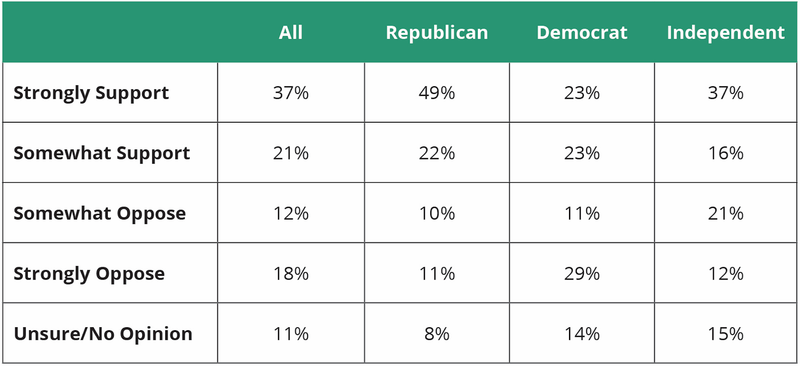
Education
Other states show school choice, funding increases can coexist
November 5, 2019
Ray Carter
Polling conducted by Cor Strategies for OCPA shows that Oklahomans are strongly supportive of school choice even as they also support making the state’s education system the government’s chief spending priority.
When likely voters were asked what area of spending they want Gov. Kevin Stitt and the Legislature to prioritize, education ranked first.
A separate poll question stated, “School choice gives parents the right to use the tax dollars designated for their child’s education to send their child to the public or private school which best meets their needs. Generally speaking, would you say you support or oppose the concept of school choice?”
The poll found 58 percent of likely Oklahoma voters support school choice, while just 30 percent were opposed, and 11 percent were unsure. The poll found 37 percent of voters were strongly supportive, more than twice the 18 percent who called themselves strong opponents.
Among Republicans, 71 percent of voters supported school choice. A majority of independents—53 percent—were supporters, as were 46 percent of Democrats. Even among Democrats, supporters narrowly outnumbered opponents, and 23 percent of Democratic respondents declared themselves strong supporters of school choice.
The poll was conducted from Monday, July 29, to Friday, August 2, and included 648 responses from likely voters in Oklahoma. The poll had a margin of error of +/- 3.85 percent. While some opponents have implied that expansion of school choice options is incompatible with greater funding for the overall K-12 system, the experience of other states proves otherwise.
Shaka Mitchell, the Tennessee director for the American Federation for Children, notes that Tennessee passed a law this year providing education savings accounts (ESAs) to up to 15,000 students in two of the state’s most educationally troubled areas, Memphis and Nashville. The ESA program allows parents to receive the state share of education dollars that would be expended on a student, which they can then use to pay for private school. In Tennessee, Mitchell said an ESA will typically provide about $7,100 per pupil.
“That’s a pretty meaningful number,” Mitchell said.
Even as Tennessee lawmakers approved the ESA program, they also “fully funded” the formula for all schools, including new money to boost minimum teacher salaries and funds for school safety programs, Mitchell said.
“There were a couple of different ways that they did to increase funding for traditional public schools and do the school-choice component,” Mitchell said.
He noted the ESA program will also free up state funds because the state will spend less per-pupil educating those students than what would have been spent had those children remained in the traditional system, which indirectly boosts per-pupil funding in the traditional school system.
Reaction to the Tennessee funding and reforms has been positive, Mitchell said, with polling showing “really high” support for the ESA portion. So far, most complaints have centered on the ESA law being too restrictive.
“The folks that I’ve heard from who have been upset with it are the ones whose cities were kind of left out of the ESA program,” Mitchell said, noting he especially heard from people in Chattanooga “who were none too happy that Chattanooga got cut out in the end.”
Jon East, vice president of Policy and Public Affairs at Step Up for Students, a Florida organization whose mission is to empower “parents to pursue and engage in the most appropriate learning options for their children,” notes that Florida has been a national leader in school choice expansion even as it boosted spending for all public schools.
“We have around 1.6 million students in pre-K through 12 now who choose something other than the traditional neighborhood school, which used to solely define public education,” East said.
That figure continues to grow and is “closing in” on accounting for half the students in Florida, he said. Florida’s school-choice policies include both public-school choice options as well as private-school options.
The expansion of school-choice policies has coincided with increases in overall education funding.
“Both in the political sense in the state legislature and then in, I would say, the larger public-consumption sense of the sort of acid test is the per-student amount,” East said. “Did that go up? Did it go down, by how much? And so we’ve seen steady climbs with that over the years.”
As with most states, there was a decline in Florida’s per-pupil funding in the years immediately following the national recession that began in 2008, but the state has subsequently experienced “healthy” growth in per-student funding, East said.
East noted that the expansion of school-choice policies was greatest when former Florida Gov. Jeb Bush served from 1999 to 2007. During Bush’s two terms, school funding experienced “rather extraordinary growth” in per-student funding, even as school-choice options expanded. During Bush’s tenure, state-appropriated per-pupil funding rose from $4,804 per student to $6,789.
While the aftermath of the Great Recession pushed per-pupil spending down to $6,267 in the 2011-2012 school year, Florida school spending has since steadily increased to $7,672 per student in the current 2019-2020 school year. East stressed that school-choice policies exist because of need.
“Not all schools serve all children,” East said. “Different children learn differently. So having an option for one set of students for whom that works is not any inherent criticism of the traditional schools that also serve many kids well. It’s just a recognition that one size doesn’t fit all.”
“School choice gives parents the right to use the tax dollars designated for their child's education to send their child to the public or private school which best meets their needs. Generally speaking, would you say you support or oppose the concept of school choice?”

Source: Cor Strategies, statewide survey on education issues in Oklahoma, July 29- August 2, 2019, 648 active likely voters, margin of error 3.85%